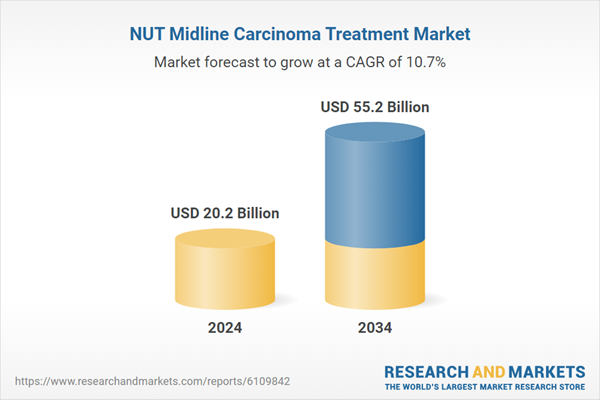Moreover, the increased availability of advanced diagnostic tools is helping healthcare professionals detect NMC earlier, contributing to higher treatment uptake. Additionally, urbanization, improved healthcare access, and higher disposable incomes in emerging markets are enhancing diagnostic rates, further fueling market expansion. Increased research funding from both governmental and non-governmental sources, along with the continuous focus on developing novel treatments like targeted therapies, are also playing significant roles in market growth.
The growing number of specialized oncology hospitals and advanced diagnostic centers is significantly contributing to earlier detection and improved management of NUT midline carcinoma, reinforcing the market’s overall momentum. These facilities are increasingly equipped with state-of-the-art technologies like molecular imaging, precision biopsy systems, and genetic sequencing tools that allow clinicians to pinpoint complex genetic abnormalities with higher accuracy. This diagnostic precision not only accelerates the initiation of targeted treatments but also enhances prognosis, which is a critical factor in rare and aggressive cancers like NMC.
The pharmacological treatment segment generated USD 15.2 billion in 2024. Technological advancements in molecular diagnostics, such as next-generation sequencing (NGS) and fluorescence in situ hybridization (FISH), have enabled precise identification of NUTM1 gene rearrangements, allowing for more targeted pharmacological treatments. Furthermore, the growing prevalence of NMC, increased diagnostic capabilities, and the rising demand for improved therapeutics options are boosting market growth. The segment is also benefitting from the development of novel therapies such as BET inhibitors and agents targeting BRD-NUT fusion proteins, which are showing promising results in early-stage trials.
In 2024, the adult segment accounted for the largest market share, with 56.3%. While NMC was initially thought to affect primarily children and adolescents, more recent studies have shown a higher incidence among adults, particularly those aged 20 to 50. This demographic shift, combined with better access to healthcare and molecular profiling tools, has led to earlier and more accurate diagnoses in adults. This, in turn, has resulted in higher treatment uptake, particularly for advanced therapies like BET inhibitors and immunotherapies.
U.S. NUT Midline Carcinoma Treatment Market was valued at USD 4.5 billion in 2024. The country is home to numerous clinical trials focused on rare cancers, including NMC. Leading institutions are spearheading the development of targeted therapies like BET inhibitors and immunotherapies. Furthermore, the U.S. FDA has granted orphan drug designations to several NMC treatments, offering incentives like tax credits, market exclusivity, and accelerated approval pathways. These incentives are encouraging pharmaceutical companies to increase their investment in NMC research and development, further propelling market growth.
Key players in the NUT Midline Carcinoma Treatment Market include Merck & Co, C4 Therapeutics, Constellation Pharmaceuticals, Pfizer, Syndax Pharmaceuticals, Bristol-Myers Squibb Company, GlaxoSmithKline, F. Hoffmann-La Roche, Ipsen Biopharmaceuticals, OncoFusion Therapeutics. Companies in the NMC treatment market focus on strengthening their position by investing heavily in research and development to create targeted therapies that address the molecular intricacies of NMC.
Collaborations with academic and research institutions allow these companies to accelerate clinical trials, while the adoption of advanced diagnostic technologies helps them gain a deeper understanding of the disease. Furthermore, companies are focusing on regulatory pathways like orphan drug status and fast-track approval to bring new treatments to market faster. Additionally, partnerships and strategic acquisitions of smaller biotech firms with innovative therapeutic solutions are helping larger players expand their product portfolios and diversify treatment options for NMC.
Comprehensive Market Analysis and Forecast
- Industry trends, key growth drivers, challenges, future opportunities, and regulatory landscape
- Competitive landscape with Porter’s Five Forces and PESTEL analysis
- Market size, segmentation, and regional forecasts
- In-depth company profiles, business strategies, financial insights, and SWOT analysis
This product will be delivered within 2-4 business days.
Table of Contents
Companies Mentioned
- Bristol-Myers Squibb Company
- C4 Therapeutics
- Constellation Pharmaceuticals
- F. Hoffmann-La Roche
- GlaxoSmithKline
- Ipsen Biopharmaceuticals
- Merck & Co
- OncoFusion Therapeutics
- Pfizer
- Syndax Pharmaceuticals
Table Information
| Report Attribute | Details |
|---|---|
| No. of Pages | 120 |
| Published | June 2025 |
| Forecast Period | 2024 - 2034 |
| Estimated Market Value ( USD | $ 20.2 Billion |
| Forecasted Market Value ( USD | $ 55.2 Billion |
| Compound Annual Growth Rate | 10.7% |
| Regions Covered | Global |
| No. of Companies Mentioned | 10 |









